-
Life threatening conditions, abode of trolls and witches:
The Alpine inhabitants of the Middle Ages avoided the mighty peaks and icy heights of the high Alpine regions. Nowadays they are accessible for tourism. Alpinism the way we know it today dates back to Romanticism, which is when several Alpine associations like the German Alpine Society (Deutscher Alpenverein) or the SAC (Swiss Alpine Club) were founded. They provided basic lodges or camps to their members. Today, on the one hand great care is taken of the Alpine environment, while on the other hand the needs of Alpine tourism must be attended to. Lately this field of tension has given rise to a few buildings worth mentioning.
Modern architecture 2883 metres above sea level: the new SAC lodge Monte Rosa
Alpine construction, with its extreme conditions, remains a challenge in engineering, as shown by the recent example of the Monte Rosa lodge.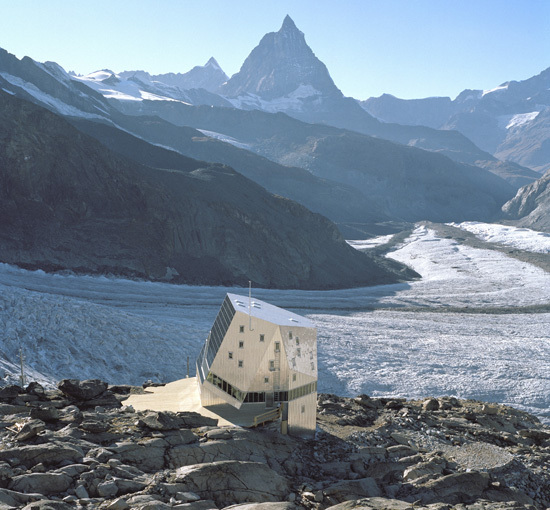 Monte Rosa lodge with Matterhorn, Photo: ETH-Studio Monte Rosa/Tonatiuh Ambrosetti
Monte Rosa lodge with Matterhorn, Photo: ETH-Studio Monte Rosa/Tonatiuh Ambrosetti -
The Swiss Federal Institute of Technology (ETH) took over the architectural and technical concept, creating a crystalline body with remote-controlled energy management from a computer at the ETH in Zurich. The energy needed for heating water and air come from solar collectors. The sewage is micro filtered on a bacterial basis and the resulting greywater is reused for flushing and cleaning purposes.
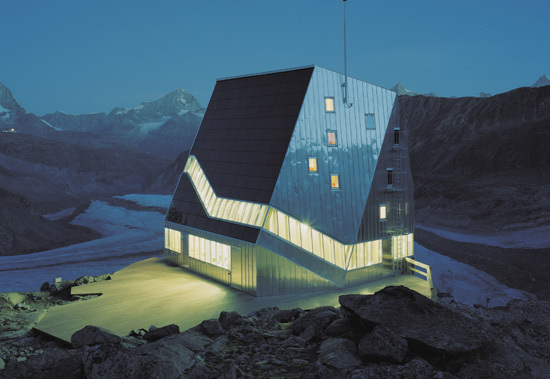 The silvery, shining aluminium cladding reflects the mood of the light, Photo: ETH-Studio Monte Rosa/Tonatiuh Ambrosetti
The silvery, shining aluminium cladding reflects the mood of the light, Photo: ETH-Studio Monte Rosa/Tonatiuh Ambrosetti -
The silvery, shining aluminium cladding and the photovoltaic structure on the southern facade conceal the wooden construction beneath. Inside, the building is more homey, the Alpine crystal has a warm, soft core and you can carve your name in the restaurant furnishings.
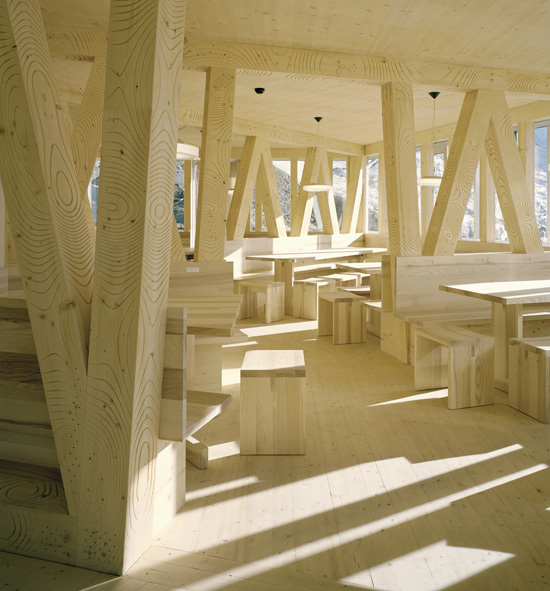 The dining hall of the Monte Rosa Lodge, Photo: ETH-Studio Monte Rosa/Tonatiuh Ambrosetti
The dining hall of the Monte Rosa Lodge, Photo: ETH-Studio Monte Rosa/Tonatiuh Ambrosetti -
Modern wood architecture
The Cappanna Cristallina in canton Ticino is a further example of the new generation of SAC cabins. After two previous cabins being lost to avalanches, the new location was analysed carefully before the launch of the architectural competition won by local architects Nicola Baserga and Christian Mozzetti.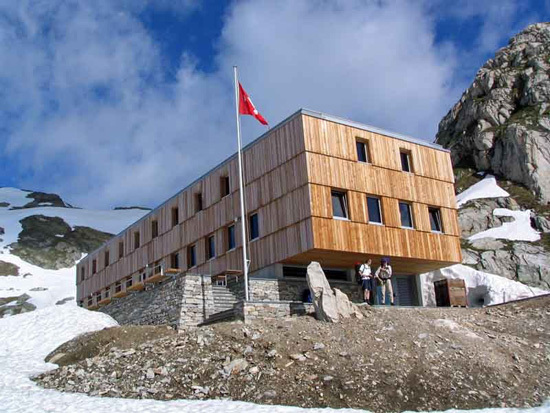 Cristallina Lodge, Valle Bedretto, Switzerland
Cristallina Lodge, Valle Bedretto, Switzerland -
They created an elongated two-storey building, with the facade facing southwards 30 metres long. Inside this box made of larch wood, nicknamed the 'cigar box', one finds a modern large-scale lodge meeting the hikers' need for space. Instead of the usual dormitories, the lodge can accommodate up to 120 people in rooms suitable for small groups. In order to keep the transportation costs as low as possible only the basement was cast in concrete. A wooden construction serves as the static framework and the roof is covered with granite slabs. Despite the economic application of materials more than 2000 helicopter flights were necessary to complete the building.
The new Pizol lodge, too, was constructed because the old SAC cabin had been destroyed - in this case by a fire. Because the cabin is situated in a ski resort next to the four-man chairlift Gaffia-Pizol, its use as a mountain restaurant is more profitable.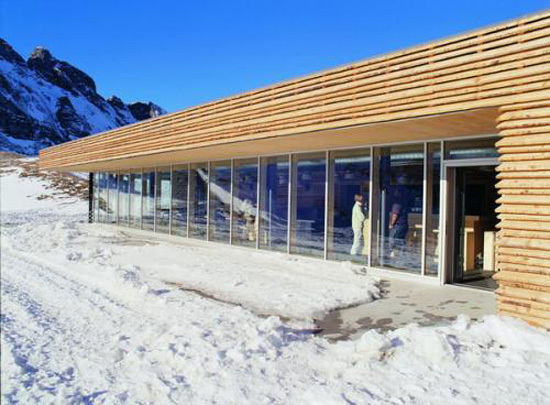 Pizolhütte, Wangs, Switzerland
Pizolhütte, Wangs, Switzerland -
In terms of construction and expression, the building resembles the Cristallina cabin. The foundation, made of site-mixed concrete, serves as base to the prefabricated wood construction. This structure was also stretched in order to provide it with a generous window facing south. This linear quality is enhanced by the facade's panelling. The lamella-like wooden cladding was laid with the boards tilted and slightly spaced, adding a filigree lightness to the facade.
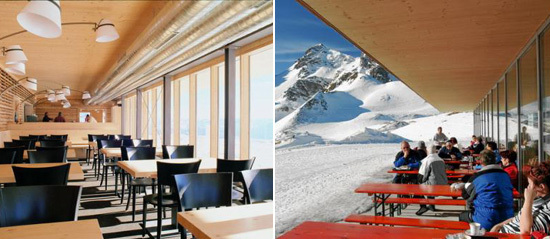 Restaurant and sun deck
Restaurant and sun deck -
The fineness of the wooden boards contrasts nicely with their rough-sawn edges. The Pizol cabin can seat 100 guests inside. A further 150 seating possibilities can be found on the terrace, and the overhanging roof on the south side can offer shelter to another 50 persons.
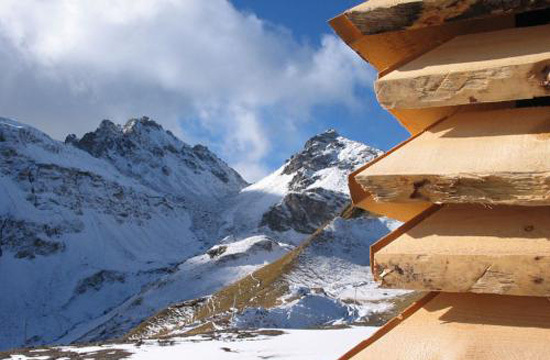 Detail of wooden boards with rough-sawn edges
Detail of wooden boards with rough-sawn edges -
Addis Abeba(r) lies in the mountains
Addis Abeba(r) in Galtür is less adapted to the local conditions. Here it is not about accommodating tough hikers, but about entertaining après-skiers starting their evening out at the bar. In spite of the building's open character and the generous use of glass, the architectsʼ focus was on ecological performance.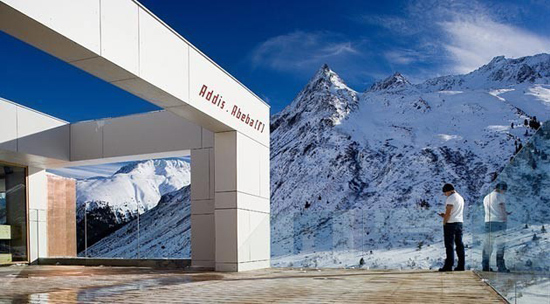 Ski lodge Addis Abebar, Galtür, Austria. Architecture: Ventira Architekten, Photo: Albrecht Imanuel Schnabel
Ski lodge Addis Abebar, Galtür, Austria. Architecture: Ventira Architekten, Photo: Albrecht Imanuel Schnabel -
The structure's surface was kept rather tight in relation to its inside volume in order to optimise energy consumption. In spite of this, the shell appears complex with bay-like windows and the integration of outside sections into the total volume. The large inside volume serves as a buffer against variations in room temperature. Inside, the bar is furnished with larch wood, rust coloured felt and dark MDF panels - a warm contrast to the white coolness on the outside.
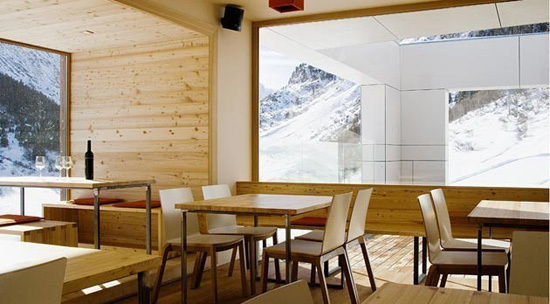 Warm materials were used for the interiors, Photo: Albrecht Imanuel Schnabel
Warm materials were used for the interiors, Photo: Albrecht Imanuel Schnabel -
Sparkling Crystal at 3000 metres
The panoramic bar with the promising name 'Top Mountain Star' is situated on the peak of Wurmkogel in Tirol. The round steel and glass dome allows for a breathtaking panoramic view. The building clings to the mountainside like an alpine tree, rooted by 25 steel anchors each 8 metres long. Those bold enough to lean over the railing will not only see the dizzying depths, but also the ubiquitous glittering Svarovski crystals on the glass balustrade.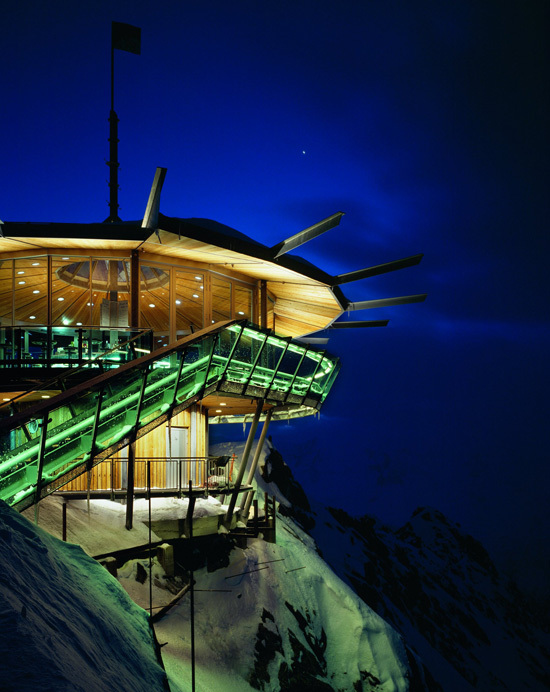 Mountain Star panoramic restaurant, Tyrol, Austria, Photo: Tirol Tourismus
Mountain Star panoramic restaurant, Tyrol, Austria, Photo: Tirol Tourismus -
Reptile of steel and glass
Reminiscent of a dinosaur's back yet futuristic: Galzigbahn in St. Anton by Driendl architects is not only an architectural success, but also an ode to technology.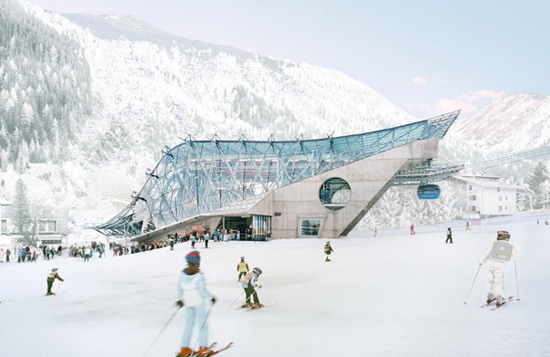 Galzigbahn St. Anton; Photo: Driendl Architects
Galzigbahn St. Anton; Photo: Driendl Architects -
The Funitel system is a world novelty in cable car construction. It allows the passenger to board on ground level without using any stairs or elevators. The difference in height is met by two 'Ferris wheels' through which the gondolas run.
 The gondola approaches to pass the giant wheel, which shifts it to ground level; Photo: Driendl Architects
The gondola approaches to pass the giant wheel, which shifts it to ground level; Photo: Driendl Architects -
The dinosaur bowels are especially apparent through the glass facade at night, when the building is lit from inside, - they are the structureʼs state-of-the-art cableway technology.
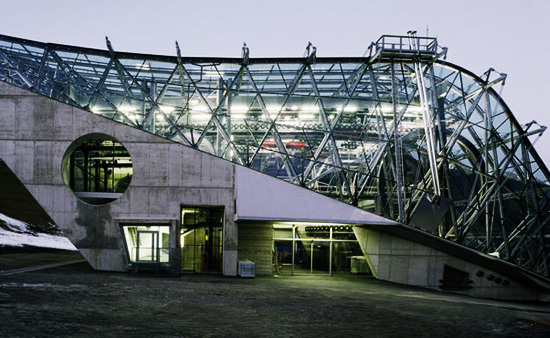 The Galzigbahn at dawn; Photo: Driendl Architects, Bruno Klomfar
The Galzigbahn at dawn; Photo: Driendl Architects, Bruno Klomfar -
Thanks to prefabrication and new methods of transportation, construction in the mountains is more efficient than ever, and better able to take into consideration the specifics of these sites in terms of construction methods and architecture – be it for the nature-oriented hiker or the entertainment seeking alpine skier.
Search Engine
Wednesday, 7 September 2011
High Alpine buildings – modern day witch houses
Subscribe to:
Post Comments (Atom)

No comments:
Post a Comment